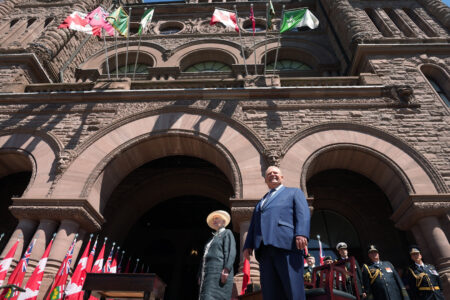
Ontario has an opportunity to be a global leader in cannabis, an opportunity that comes with thousands of jobs and considerable economic growth. With province recently putting an end to the retail lottery system for stores and the arrival of legal edibles, extracts and topicals, the province is at an exciting crossroads. If the government continues along a path of reform and develops a strategic policy and regulatory regime now, we could do more to thwart the illicit market and give Ontario a competitive advantage.
Ontario has 24 cannabis retail stores for 14 million people, with another 50 authorized licenses expected to be operational by spring. In comparison Alberta, a province with a population of 4 million people, has opened and supported over 300 privately owned stores. Estimates suggest Ontario’s cannabis market could support 1,000 retail stores and create 14,000 jobs in the retail sector alone. The reality today is that Ontario’s lacklustre retail footprint over the first year of legalization has underserved the market, done little to stop illicit actors from profiting and represents a lost opportunity for industry growth and tax revenue.
The decision to end the retail lottery and move to an open allocation model is welcome and provides much needed clarity to licensed producers (LPs) and retailers, but the time horizon for when Ontarians will start to see more legal retail outlets through this model is ultimately tied to the rate of allocation. As of April 2020, the government will begin authorizing new stores at a rate of 20 per month, with the aim of having 250 stores operational by the end of 2020. This will undoubtedly go a long way toward helping to suppress the illegal market by making legal cannabis more accessible for Ontarians.
But at the rate of just 20 stores per month, Ontario will not reach 1,000 stores until 2024. A faster monthly rate — something that is surely feasible given the demand for cannabis in a province of Ontario’s size — would improve market penetration and customer convenience. It would also do more to combat the illicit market by providing Ontarians with more options to purchase cannabis from legitimate channels.
To be clear, however, suppressing the illicit market will require more than just expanding the number of retail stores. Ontario must also establish a regulatory regime that fosters a fair and competitive market capable of effectively competing against illicit actors on price, product differentiation, quality and convenience. As things stand, the illegal market has the advantage when it comes to these factors.
This is in large part because of the structure of the cannabis retail distribution system in Ontario. The Ontario Cannabis Store (OCS) acts as the province’s exclusive wholesaler and online retailer of legal recreational cannabis. This means it is responsible for purchasing cannabis products from LPs, setting the prices and markups, and distributing the product to retailers.
The current structure threatens Ontario’s competitive advantage in cannabis and undermines economic opportunity. A model in which LPs directly negotiate with retailers would bring prices down by enabling both parties to negotiate their product mixes, prices, terms and conditions. The OCS, meanwhile, could play an oversight role as regulator, ensuring the rules governing the sector are sound and evolve appropriately to reflect industry and consumer trends.
Having a direct LP-retailer relationship would also allow for independent retailers and craft LPs to succeed by building their brands and focusing on specialty areas of the market. For instance, a small craft LP could enter into a long-term supply arrangement with an independent retailer in Ontario to establish a new product line and brand at an exclusive price to that boutique retailer. This is the model in Saskatchewan, and it is working there.
Fire and Flower, a licensed retailer in Saskatchewan, supplies 7 corporate stores and 32 additional independent small business retail stores with a staff of 6 people. This retailer has been able to source product at competitive prices through direct relationships with LPs without incidents of short or late shipping. (Short or late shipping is a concern for retailers in other provinces as consumer preferences are becoming clearer, creating a shortage of certain products.) In Saskatchewan, retailers can sell online directly to consumers and distribute wholesale to other retailers in an exceedingly efficient marketplace, where multiple distributors and retailers compete with each other. For approximately $2 million of private capital, Fire and Flower also successfully established a distribution warehouse that can service 100 stores at a fraction of Ontario’s overhead expenses for servicing just 24 retailers.
As it stands now, no provincial regulatory guidelines for Cannabis 2.0 for retailers have been released, nor have there been any consultations with industry stakeholders.
The importance of having a legal competitive private retail market for cannabis will only be heightened when “Cannabis 2.0” products – vapes, edibles, topicals and extracts – are made available to Ontario retailers on January 6. These products contain varied potencies and have different incubation periods before their effects are felt, meaning educating consumers at point of sale is of critical importance. Educating consumers on these new products is also aligned with public opinion: Over two-thirds of Ontarians believe retailers should educate consumers at the point of sale, according to a survey conducted by Responsible Cannabis Use.
Ensuring a smooth rollout of these products means avoiding the supply-chain challenges that emerged over the last year between suppliers, regulators, distributors and retailers. The provincial government and the OCS need to provide clarity to industry (particularly retailers) around the rules and regulations for the procurement, storage and sale of these new products.
As it stands now, no provincial regulatory guidelines for Cannabis 2.0 for retailers have been released, nor have there been any consultations with industry stakeholders. For instance, retailers do not know how these products can be safely stored or displayed in their stores, or whether consumers are allowed to interact with the product. With cannabis beverages entering the market, something as simple as whether these beverages are allowed to be refrigerated or chilled remains unknown. With the second wave of legal products just weeks away in Ontario, the government must move expeditiously to address these questions as well as any logistical barriers that could hamper the distribution and sale of new products.
While there is plenty of room for improvement in Ontario’s roll-out of legalized cannabis, perspective is important: With $216 million in sales, the province still had the highest cannabis sales in the first year of legalization, despite its disproportionately low number of retail outlets. And the Ontario government has shown a willingness to reform the system with the implementation of an open allocation model for private retail. There have been – and will continue to be – growing pains, but progress is being made.
With Ontario home to approximately half of Canada’s 243 LPs with the majority of cannabis employment at nearly 6,000 people and the largest domestic consumer market, the province is in a position to lead the cannabis industry not only across the country but around the world as it fosters a successful, competitive market. Capitalizing on that opportunity will require a set of policies that strike the right balance between supporting the long-term viability of the sector, safeguarding public health, and combating the illegal market.
This article is part of the The Making of a Cannabis Industry: Year One special feature.
Photo: Organigram Inc.
Do you have something to say about the article you just read? Be part of the Policy Options discussion, and send in your own submission. Here is a link on how to do it. | Souhaitez-vous réagir à cet article ? Joignez-vous aux débats d’Options politiques et soumettez-nous votre texte en suivant ces directives.









